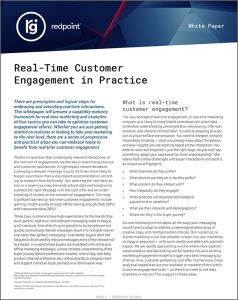 Amid all the speculation on the lasting impact coronavirus will have on the retail industry, a common denominator among customer-facing changes is likely to be a greatly enhanced focus on digital customer experience – already a priority for retailers looking to drive new revenue with highly personalized experiences across omnichannel customer journeys.
Amid all the speculation on the lasting impact coronavirus will have on the retail industry, a common denominator among customer-facing changes is likely to be a greatly enhanced focus on digital customer experience – already a priority for retailers looking to drive new revenue with highly personalized experiences across omnichannel customer journeys.
Consider, for example, the 2019 Harris Poll sponsored by Redpoint, where 63 percent of customers surveyed said that personalization is part of a standard service they expect. What was an imperative for many forward-thinking retailers has now become an imperative for all: the ability to provide a consistent, cohesive and personalized experience across channels. This capability will likely determine which retailers survive the new reality marked by rapidly evolving social interaction rules resulting in more dynamic, unpredictable and mostly digital customer journeys.
The New Customer Journey
There is a general acceptance that changing consumer behavior will, in some shape or form, entail physical distancing: a shift to contactless payment, curbside pickup, buy online and pay in-store (BOPIS) with no human interaction and grocery delivery to name a few. A newly reimagined in-store experience may mean wider aisles, customer limits or appointment-only visits. There is also speculation about what the future of retail means for ecommerce, and how changes will impact CPG brands and the shift to a direct-to-consumer (DTC) approach.
New reporting shows that consumer behaviors are already shifting. According to Sense360, 31 percent of US households used a grocery delivery service over the last four weeks, up 18 percent over a four-week period last summer. Walmart reported $900 million in online grocery sales in March, up 21 percent from February – and up 99 percent from March, 2019. According to Rakuten Intelligence, the dollar volume of BOPIS orders for all kinds of retail (grocery and non-grocery) grew 111 percent year-over-year for a period of time in March.
Changing with the Times
A recent blog in this space discussed the acceleration of digital and omnichannel engagement amid this shifting and uncertain landscape. While every industry is being impacted, retailers may be those most deeply affected by changing consumer preferences, simply by the prospect of having to evolve on two fronts – digital and physical, with physical distancing measures in addition to an enhanced online experience.
Compounding this is unprecedented changing consumer behaviors. These behaviors are highly unpredictable at the moment, and current behaviors are disconnected from past history. The key is to understand and act on changing consumer behavior in the moment, which almost guarantees that retailers will have to evolve to prepare for this new reality. Evolution will likely take one of three forms:
- A shift to a digital-first/digital-only model – A Business Insider article examines the potential fate of the brick-and-mortar store. The CEO of PVH Corp. (Tommy Hilfiger, Calvin Klein) predicts that up to 25 percent of US stores will close in the next two years. Retailers will face tough choices on the value of reconfiguring physical stores vs. devoting those resources to creating a better online shopping experience.
- Leveraging digital and physical assets – Some retailers who were in front of changing consumer behaviors are now well-positioned to create differentiated customer journeys that prioritize customer experience. For example, Walmart, Kroger, Target and Best Buy are among a group of successful retailers already pioneering curbside pickup, which Cowen estimated would be a $35 billion channel this year. While that estimate was made before coronavirus upended the industry, the service offers a model for others to follow to create a new experience for consumers who may be wary of physical interaction, yet eager for the convenience of same-day pick-up and easy returns.
- A complete re-invention – CPG brands in particular will likely become less dependent on retail as a last mile to the consumer, and continue to invest in creating innovative direct-to-consumer (DTC) channels. According to analysis from Nielsen and Rakuten, for the week ending April 11 online sales of CPG products rose 59 percent compared with the same 2019 timeframe. A “doubling down on digital channels” includes CPG behemoths investing in digital-native start-ups, and coming up with other innovations to increase brand loyalty that reduce a reliance on traditional retail partners.
Start with a Deep Understanding of the Customer
Whichever path a retailer takes, the most complete, freshest and accurate understanding of the customer is a foundational requirement to enable a superior customer experience. True before, the need becomes more urgent as behaviors change and new channels emerge.
A state-of-the-art curbside pick-up service, for instance, has a lot of moving parts. Each interaction – web browsing, shopping cart fulfillment, a transaction, pick-up logistics – offer an opportunity to delight the customer with a personalized experience. Conversely, there is ample opportunity to fail – a failure to recognize the customer across multiple devices, a poor website experience, miscommunicating pick-up details, ill-timed offers, etc. Mistakes do nothing but create friction with the customer and result in sub-optimal outcomes for the retailer.
Orchestrating a seamless, personalized experience across an omnichannel journey begins with having a single customer view. The Redpoint Golden Record provides brands and retailers with every source of customer data – structured, unstructured, semi-structured, first-party, second-party, third-party, IoT, sensor, etc. – for a 360-degree view of the customer. A continually updated record – which includes a customer’s preferences, behaviors and transactions combined with a rich contact graph – enables marketers to keep pace with a customer journey in real time across all channels and devices, and meet each interaction with a perfectly timed and relevant next-best action.
By delivering relevance at every interaction, retailers and brands demonstrate that they know a customer as an individual, aligning with customer expectations for personalization. In the Harris Poll sponsored by Redpoint, 52 percent of customers surveyed said that they define personalization as a brand sending them special offers that are only available to them, and 43 percent said that it is when a brand knows them as the same customer across every touchpoint.
The changing retail landscape will make the need to deliver real-time personalization within the context of a dynamic customer journey a necessity. Customers have already stated that they expect personalization as a standard service. It is now a strategic imperative for retailers and brands to fulfill this expectation or be left behind in the new reality.
RELATED CONTENT
Satisfy the Customer Expectation for a Personalized Experience with Intelligent Orchestration
Cadence of the Customer and the Corner Store Experience
A Personalized Customer Experience Delivers Loyalty
Be in-the-know with all the latest customer engagement, data management, and Redpoint Global news by following us on LinkedIn, Twitter, and Facebook.


